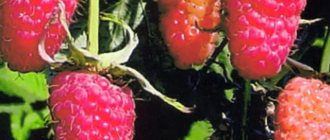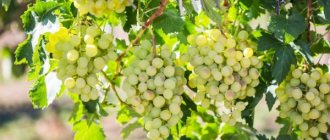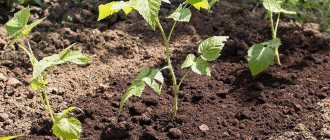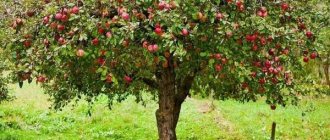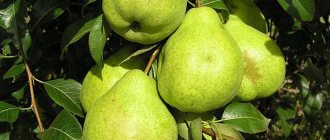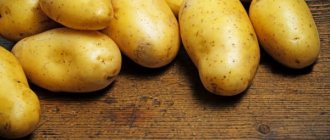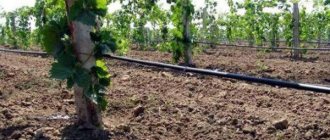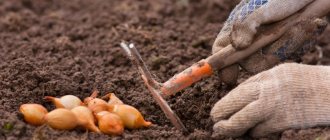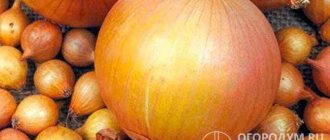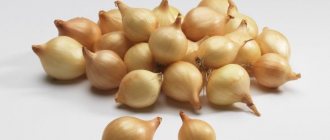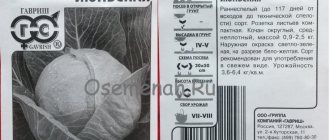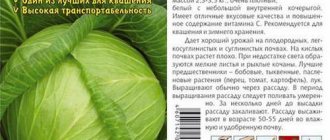The Semerenko apple tree variety is an old Russian variety known as “Renet Simirenko”, “Green Renet Simirenko”, Simirinka (this is in Ukrainian) and Semerenko. It received its name in honor of the gardener-breeder Platon Fedorovich Simirenko, who was the first to cultivate it in the 19th century.
He suggested that the new variety of apples was created due to the free cross-pollination of different apple trees and the growth of their seeds.
Apple tree Semerenko
The Simirenko apple tree is a native Russian variety, unknown in Europe, but very popular throughout the southern part of Russia and the Central Black Earth District. It has also become widespread in Ukraine.
The Simirenko variety of apple trees was included in the State Register of the Soviet Union in 1947.
Advantages of the variety:
- Good yield;
- Precocity;
- Long-term storage of apples;
- Heat and drought resistance;
- Large size apples.
Large fruits are one of the advantages of the Simirenko apple tree.
Disadvantages of the variety:
- High susceptibility to scab and powdery mildew;
- Tendency to thicken the crown;
- Frequency of fruiting in adulthood.
- Low winter hardiness;
Climatic zones with mild and warm winters, such as the Krasnodar Territory, North Ossetia, Georgia, Abkhazia, North Ossetia, and Ukraine, for growing this apple tree
Further in the article we present to your attention a description, photo and gardeners’ opinion about this variety.
Characteristic
Tree
Tall, with a wide-round spreading crown. The bark on the trunk and branches is dark gray, with an orange tint on the sunny side.
Apple tree Semerenko.
Escapes
Straight, green-brown, medium thickness. Their lentils are small and sparse.
Annual shoot growth
Provided proper agricultural technology reaches 50-60 cm in a young seedling and 45-55 cm in an adult.
Leaves
Elongated, ovoid, curved in the shape of a boat at an angle of up to 90°. Their tip is twisted. The color of the leaf is light green, and the surface is slightly shiny, with fine serrations along the edges.
Fruit
Medium-large or large , regular round shape; their surface is flat and smooth. When technically ripe, their color is light green; during storage, the apples turn yellow. Fruits growing in full sun often develop a faint pink blush .
Apples Simirenko.
The average weight of an apple is 150-180 g. , when rationing the harvest, the weight increases to 200 grams.
Important! Yield rationing is the removal of part of the ovaries from the tree.
On the entire surface of the fetus there are many subcutaneous dots - light and large, 2-3 mm in diameter.
The apple pulp is creamy white, very tender and juicy. The taste is sweet, with a pleasant aftertaste of spices. The sugar content in the pulp is from 8 to 12%, and acids - 0.4-0.7%. The content of ascorbic acid is 8 mg per 100 g. fetus
You can appreciate the fruits of the Semerenko apple tree in the following video:
Tasting assessment
4.5-4.7 points.
Productivity
High. 140-170 kg is harvested from an adult tree . An eight-year-old tree produces 12-15 kg of apples.
The Semerenko apple tree is characterized by high productivity.
Precociousness
Good. The tree produces a harvest 4-5 years after planting.
Deadlines
Blooms
Second half of May.
Flowering of the Semerenko apple tree.
Fruit ripening
Second half of September – mid-October.
Harvest storage
Until next summer. Possible storage until the next harvest.
Renet Simirenko can be stored until the next harvest.
Winter hardiness
Not tall, the tree is severely damaged by frost at a temperature of – 25 °Ϲ.
Disease resistance
Below average, especially for scab and powdery mildew.
Pollinator varieties
The best varieties for Simirenko are:
- Idared;
- Korea;
- Golden Delicious;
- In memory of Sergeev;
- Kuban Spur.
Idared.
Korea.
Golden Delicious.
In memory of Sergeev.
Kuban Spur.
Watch Semerenko's apple tree review in the video below:
Botanical description of the tree
The Renet Simirenko apple tree has some disadvantages. It is susceptible to the diseases “Scab” and “Powdery mildew”. To keep the tree healthy, the crown needs to be adjusted. If this is not done, it will actively grow. The Simirenko apple tree variety needs shelter. The tree is not resistant to cold weather. It prefers to grow where the climate is warm. The variety is grown in Georgia, Abkhazia, and the Krasnodar Territory.
Renet simirenko is a tall tree with a massive crown. Its bark is dark gray with a slight orange tint. The shoots are rich green and medium in thickness. If the rules of care are followed, they grow by 55 cm per year. The botanical description indicates that the leaves of this crop are curved. The foliage is light green in color and has a glossy surface.
The fruits are valued for their unique taste and rich composition. Their surface is smooth. When stored for a long time, they acquire a yellowish tint. Growing apples are salad green with a slight pinkish tint. The average weight is 160 g. If the ovaries are removed in a timely manner, the fruits will be juicy and reach a weight of 200 g. Their flesh is white, with a slight creamy tint, and it tastes sweet and sour.
The variety gives a rich harvest. With proper care, the gardener gets 160 kg from one tree. Fruiting occurs 4-5 years after planting. Flowering begins in May. Simirenko apples are stored at temperatures from +5 to +25 degrees. As noted, the variety does not tolerate frost well. It is necessary to store fruits in proper conditions.
Reviews
This popular variety is often discussed on gardening forums.
Evgeniy Sergeevich, 54 years old, Donetsk. ‟ My father planted Semerinka, and now this apple tree is already 50 years old. It is the largest on the site, it provides a lot of shade. It doesn’t bear fruit every year, but it produces large apples.”
Alena, Volgograd. ‟ We have two Semerinko apple trees. We bought one tall, and the second on a dwarf scion. Both grow well, but the tall one grows faster. They have been bearing fruit for 5 years, but every year we struggle with scab! In rainy years, powdery mildew also appears. I spray the entire garden twice a year to prevent the infection from spreading.
The apples themselves are tasty and juicy, and last a long time! I put them in boxes in the basement, sprinkle them with dry sawdust, and we keep them until May. We would have stayed longer, but we eat them all))).”
Vladimir, Chelyabinsk. ‟ I planted this apple tree without knowing about its low frost resistance. And now every year I cover it and throw snow up to the trunk. One year all her branches froze, but over the summer she threw out new ones as much as a meter long. And the next year it was already bearing fruit! One of the advantages I would like to note is its unpretentiousness. All she needs is insulation for the winter and treatment for fungal diseases. She does everything else herself.”
Diseases and pests, control methods and prevention
There are 4 main pathologies in apple trees:
- Black cancer is a terrible and rapid fungal disease. It attacks the tree from the inside and quickly spreads to neighboring plantings. In a few years it can destroy the entire garden. In affected areas, the tree looks burnt, the bark cracks, the leaves and fruits darken. For treatment at the initial stage, all affected fruits, leaves, branches, and bark should be removed. Treat remaining wounds with powerful antiseptics. Treat the entire garden area with antifungal agents. If the disease cannot be detected at the initial stage, it will no longer be possible to save the tree.
- Scab - fruits become stained, deformed, and develop poorly. The leaves become darker and fall off. It is treated with a number of special medications after flowering so as not to harm pollinating insects.
- Powdery mildew - a powdery coating forms on the leaves and shoots. The leaves curl and fall off, the inflorescences are lost before the ovaries form. It is treated by spraying with a solution of colloidal sulfur.
- Cytosporosis - flowers and leaves dry out but do not fall off. Cracks appear on the bark. It is treated by removing the affected areas of the bark followed by disinfection. The next year, in early spring, the tree is sprayed with a special preparation.
Scab on an apple tree.
With decent and timely care, digging and mulching the surrounding tree trunk, treating plant wounds, and keeping the garden area clean and tidy, the trees will be healthy throughout their lives
Apple trees can be subject to detrimental effects on their health from parasitic insects such as aphids, codling moth, and apple flower beetle. The problem is eliminated by the use of special insecticides before or after flowering to avoid harm to pollinating insects.
Landing
Growing conditions
Apple tree Renet Simirenko loves fertile and breathable soils . It tolerates heat and drought well, and can grow on hills and small slides that are poor in moisture.
Deadlines
The Simirenko apple tree is planted at the same time as other apple trees: from mid-April to mid-May in the spring, and from late September to mid-October in the fall.
Semerenko can be planted in both spring and autumn.
Technology
Dig a planting hole 50 cm wide and deep, loosen the bottom with a shovel. For heavy soils, make a larger hole , approximately 70-80 cm in width and depth, and the removed soil is diluted with sand:
- Drive a strong peg 1.5-2 meters long into the bottom of the hole.
- Shorten the roots of the seedling by 3-4 cm, remove broken and dented roots.
- Make a small hill in the center of the hole and place the roots of the apple tree on it, carefully spreading them in different directions.
- Fill the hole with soil, pressing it down with your hands, and tie the seedling to a peg.
- Water the tree with 2-3 buckets of water.
Advice! If you prepare the hole in advance, 1-2 weeks before planting, it will be better saturated with moisture, and the deep layers of the soil will be saturated with oxygen.
Watch the video on how to plant apple trees correctly:
Scheme
The Simirenko apple tree has remarkable growth power and can spread 4.5-5 meters in width. Due to its thick crown, it greatly shades the ground beneath it, and this must be taken into account when planting it next to other plants.
To ensure that all plants have enough light, the Simirenko apple tree is planted at a distance of 4.5-5 meters from other trees. If your seedling is grafted onto a semi-dwarf rootstock, the distance can be reduced to 3.5-4 meters.
Scheme of planting apple trees depending on the rootstock.
History of the apple tree Renet Simirenko
The name of the variety Renet Simirenko has been heard since childhood. Many people prefer these apples, despite the fact that there are brightly colored giant fruits lying on the counter nearby. In winter, the variety is a top seller.
Apples of the Renet Simirenko variety help strengthen and heal the children's body
The Renet Simirenko variety is very old. It is not known for certain who bred it, but this apple tree and its fruits were discovered and described by the famous gardener and pomologist Lev Platonovich Simirenko. This happened not far from the city of Mliev, which is located in the Cherkasy region, in the distant 80s of the 19th century. The new variety was named by the scientist in honor of his father, Renet Platon Simirenko. But over time, the name of the apple tree changed, and now it is well known as the Renet Simirenko apple tree.
The variety was included in the State Register of Russia in 1947. In Ukraine it is recommended for cultivation in steppe, forest-steppe zones and woodland. In Russia, the apple tree is widespread in the North Caucasus and Lower Volga regions.
Video: Crimean apples of the Renet Simirenko variety
Agricultural technology
This apple tree is unpretentious and will bear fruit even if you don’t take care of it. But to get large apples and a high yield, it will require proper pruning, disease prevention and fertilizing.
Protection from diseases
Prevention of fungal diseases is necessary for any variety that is weakly resistant to diseases such as scab and powdery mildew. It is started in the spring, before the buds open, by spraying the branches and trunk of the tree with a weak solution of Bordeaux mixture.
After flowering, biofungicide preparations are used, such as:
- Fitosporin,
- Raek,
- Zircon.
Their solution is safe for humans, and fruits from a treated apple tree (if you believe the instructions) can be eaten even on the day of treatment.
Important! In the fall, all fallen leaves are collected from the area and burned away from the garden so that the scab and powdery mildew fungus cannot overwinter in them.
Crown trimming and shaping
Annual pruning of the apple tree is necessary when the crown is very thick, to which the Simirenko apple tree is very prone. If it is not carried out, the tree is more easily affected by diseases, the yield and weight of fruits decrease.
Apple tree pruning diagram.
When pruning an apple tree, remove from it:
- Sick and damaged branches;
- Growing down and touching the ground;
- Growing vertically upward (tops);
- Growing too close to each other.
Pruning is done during the tree's vegetative dormancy , i.e. late autumn or early spring. The cuts are covered with garden varnish, and the cut branches are taken out of the garden.
Watch the video on how to properly trim a Semerenko apple tree:
Fertilizer application timing
The apple tree is fertilized in the spring - in April-May , and in the fall - in September.
For spring feeding, choose nitrogen-containing mixtures , such as:
- Urea,
- Ammonium nitrate,
- Ammonium sulfate,
- Humus,
- Manure or bird droppings.
Attention! In dry weather, fertilizers are diluted in water and watered under the tree trunk. In wet weather, fertilizers are incorporated into the soil, loosening the soil under the crown.
During autumn fertilizing, potassium-phosphorus fertilizers are added to the soil, which are necessary for planting the future harvest. This can be potassium sulfate and superphosphate, wood ash. Nitrogen fertilizing is not applied in the fall, so as not to cause rapid growth of shoots on the eve of winter.
If there is a lack of microelements, foliar feeding is done during the summer. For this purpose, preparations Kemira Lux, Aquarin and any others containing copper, zinc, iron, magnesium, sulfur and boron are suitable - necessary for good tree growth.
The fertilizer is diluted in the specified amount of water and sprayed onto the entire crown of the tree in the late evening or early morning. The deadline for such fertilizing is 2-3 weeks after the apple tree blooms.
How to care for culture
In order to receive a harvest of Semerenko apples every year and not undermine the vitality of the tree, you should carefully care for it. Maintenance work includes:
- Application of nitrogen-containing fertilizers.
The compositions are added twice: in the spring season - in April-May, in the autumn season - in September:
- urea;
- ammonium nitrate;
- ammonium sulfate;
- humus;
- manure or bird droppings.
Good to know! Fertilizers are diluted in water and, in dry weather, poured under the tree into the circle around the trunk. If it rains, then the soil around the trunk is loosened and fertilizers are embedded in the soil.
In autumn, with the help of potassium-phosphorus fertilizers: potassium sulfate, superphosphate and wood ash, you can activate the formation of flower buds for the future harvest. Fertilizers with nitrogen are not applied, as the shoots will begin to actively grow on the eve of the cold period. In order to have enough microelements for life in the summer, foliar feeding is carried out with Kemira Lux, Aquarin and any other means with copper, zinc, iron, magnesium and boron. Fertilizers are diluted according to the instructions and the entire crown of the apple tree is sprayed early in the morning or late in the evening 2-3 weeks after the end of the flowering phase.
- Watering apple trees
Despite their drought resistance, the trees will do well with three waterings per season. Under each tree you need to pour 30-50 liters of water before flowering, before fruit set, 2 weeks before apples ripen. Young seedlings are watered a third time at the end of July to prepare them for winter.
- Pruning shoots
In young trees, shoots that have reached a length of more than 60 cm are pruned. This will preserve annual growth with future fruit set. The crown of mature trees is thinned out to prevent thickening and reduced fruiting. At the same time, they get rid of branches:
- sick and injured;
- growing downwards, right up to contact with the ground;
- too close together;
- tops growing vertically upward.
Pruning work is carried out when apple trees are vegetatively dormant: in early spring or late autumn. It must be remembered that the cuts should be covered with garden varnish, and all cut material should be destroyed outside the garden.
- Insulation for the winter
Unlike heat, heat and wind, this crop does not tolerate frost. Therefore, the following work is performed:
- mulch the tree trunk circle;
- the trunk is wrapped in thermal insulation materials to retain heat and protect against rodents;
- The branches are covered with stakes and a film or the same thermal insulation materials from the store are secured to them.
- Treatment of diseases and extermination of pests
Trees are affected by scab and powdery mildew. As a preventative measure, last year's fallen leaves, twigs, and dried fruits with parasitic lesions are removed and burned. The trunk should be whitened with lime or chalk, the green mass should be sprayed with preparations such as Polycarbacin or Euparen at the beginning of the season, as well as Bordeaux mixture (a weak solution) before the buds open. After the flowering phase, they are treated with biofungicides: Fitosporin, Zircon, Raek.
In dry seasons, treatment is repeated 2 weeks before harvest to prevent scab from appearing on mature fruits. To destroy harmful parasites, trees are treated with copper-containing products in early spring. The crop is regularly treated with Zircon for prevention to improve its overall resistance and endurance to harmful environmental factors.
Grows poorly, does not bloom, does not bear fruit
Young trees sometimes cannot adapt to new living conditions. This happens for the following reasons:
- if the planting was too deep, the root collar was covered with earth;
- deficiency of microelements in the soil;
- moles and shrews damaged the roots;
- groundwater is high and leads to rotting of the roots;
- the aphid sucked the juices out of the plant.
The reasons can be eliminated for the active growth, flowering and fruiting of apple trees:
- open the root collar above the soil level;
- inspect the green mass and twigs and treat everything against pests;
- feed the plant with mineral fertilizers containing iron, in the spring - with nitrogen, in the fall - with potassium and phosphorus;
- carry out a quick fertilizing of green leaves using a weak fertilizer solution.
Good to know! To free the root collar, you need to dig up the tree from all sides and lift it by sliding a shovel under the root. If groundwater is close, the tree is transplanted to another, higher place.
You need to know that apple tree shoots can grow excessively. The tree is fattening and does not have enough strength to bear fruit. If the growth of the shoots is higher than 45-50 cm, then nitrogen fertilizing needs to be reduced. If the branches grow vertically, then ringlets and fruits do not form. The future harvest is formed on them. In this case, a trellis is needed near the tree; branches need to be tied to it and placed vertically.
“Henrik” - the meaning of the name, the origin of the name, name day, zodiac sign, mascot stones
If there is a deficiency of iron in the soil, the growth of apple trees slows down and fruiting becomes worse. Then the tree is fed with iron sulfate: 1 tsp/8-10 l of water. Various small iron products are buried in the tree trunk circle. Ferovit solution is sprayed onto the leaves: 4 drops/1 liter of water.
If the flowering phase has passed, but the fruits have not set, then the time for the buds to open is:
- return frosts damaged the flowers;
- it was too hot or it was raining;
- pollinating insects stopped flying in such weather;
- pest control treatments were carried out, which the bees do not like.
If there were ovaries after flowering, but partially fell off in June. This is how the tree relieves its load. If all the ovaries have fallen off, then there are fungal diseases:
- powdery mildew;
- late blight;
- apple tree cancer
It is necessary to carry out treatments for these diseases, as indicated above. The ovaries also fall due to freezing of the roots and crowns last winter. You need to take care of covering apple trees during the cold period.
Rootstocks for seedlings
The Semerenko apple variety is grafted onto vigorous or clonal rootstocks. The tree will be tall, up to 7 m and unpretentious. It will begin to bear fruit only after 6-7 years and will live for 50 years. Such trees need a large area and soil with a high groundwater table.
If the rootstocks are semi-dwarf, then the height of the tree will be less, up to 4.5-5 m. The plant will produce fruits for 4-5 years; it will tolerate groundwater levels at a level of 2.5-3 meters. When grafted onto a dwarf rootstock, the apple tree bears fruit 2-3 years after planting, it will grow in height to 2.5-3 m, and live 25-30 years.
Features of fruiting and ripening
Attention! For successful fruiting, this variety needs pollinators growing at a distance of 100-150 m from the tree. The Simirenko apple tree blooms in the last ten days of May and apple trees blooming at the same time will become pollinators for it.
Young trees bear fruit annually, but at the age of 25-30 years the periodicity of yield begins, i.e. One year the apple tree bears fruit, and the next it rests.
Technical ripeness of apples occurs at the end of September - beginning of October. When picked, they are dense and sour, but after a month of storage they lose some of their sourness and become softer.
The main advantage of the Simirenko apple tree is that its harvest can be stored for 8-9 months after harvest ! No other variety can boast such keeping quality!
Renet Simirenko is the lightest of the known varieties of apple trees.
Rules for storing apples so that they please you until next summer:
- Apples taken from the tree in dry weather are suitable for storage.
- Before storage, you need to inspect each apple, selecting only whole fruits without damage, bruises or wormholes.
- Selected apples are packed in cardboard boxes or wooden crates. It is important that the container is dry and clean.
- Packed apples are placed in a cold place with a temperature of 1 to 8 °Ϲ. This could be a refrigerator, a cellar, the basement of a house, or an insulated balcony.
Advice! Treating apples with propolis solution will help increase shelf life.
Eliminating periodicity
In the Simirenko apple variety, many gardeners are not satisfied with its frequency of fruiting.
Why doesn’t a mature apple tree bear fruit every year? This is due to the fact that in adulthood the tree needs more nutrients to form a crop and maintain its crown.
In order for the tree to bear fruit annually, you need to prune it, removing up to a quarter of the crown, and feed it well.
Then it will begin to actively form spears and fruits, on which the future harvest is formed.
Harvest and storage
Ripe apples hold tightly to the branch, but you should not delay harvesting. After all, the autumn weather is very changeable, and you can’t pick fruits after rain, they will quickly begin to spoil. So choose a clear, sunny day and get started.
Start picking apples from the lower branches, gradually moving up. Try to pick the fruits carefully, including the stem. This is important for extending shelf life. Be sure to sort the picked apples. Those that have damage or signs of disease, immediately put them in a separate container and put them into recycling. Place whole, strong fruits in wicker baskets or plastic boxes.
Simirenko's fruits show excellent keeping quality - the marketable yield can reach 90%.
Simirenko apples show excellent keeping quality
It is best to store apples in a room with ventilation and a constant temperature of about 0 ° C, maintaining high humidity - up to 85%. In such a place, the harvest can last from six months to 8 months. Proper storage improves taste.
Simirenko apples are an excellent example of a universal fruit. You can make jam, marmalade and marshmallows from them. Fans of unusual winter salads can be advised to make soaked apples. Long shelf life allows you not only to consume the fruits in their natural form, but also to use them as an ingredient for strudels, casseroles and pies.
Simirenko apples are ideal for baking
Varieties and options
When buying a seedling, it is important to know not only the characteristics of its variety, but also the type of rootstock on which it is grafted. What are they and how are they different?
Vigorous or clonal rootstock
Produces the tallest and most unpretentious tree. It lives for more than 50 years , grows up to 7 meters in height, but will begin to bear fruit only 6-7 years after planting.
Important! Such trees are not planted in small areas and on soil with high groundwater levels.
Semi-dwarf
This rootstock reduces tree growth to 4.5-5 meters in height, and its lifespan to 40 years . The semi-dwarf apple tree will begin to bear fruit in 4-5 years, and will get along well with groundwater at a level of 2.5-3 meters.
Dwarf
This rootstock allows for rapid fruiting - 2-3 years after planting! But it does not live long - 25-30 years, growing no more than 2.5-3 meters in height.
Columnar
There is no variety of columnar apple tree called Simirenko, so we will briefly describe columnar apple trees in general.
They are very compact, they can be planted in increments of 50-70 cm. They grow no higher than 2.5-3 meters in height and bear fruit well in the first 10-12 years of life.
Similar varieties
The main advantage of the Simirenko variety, due to which it has been so popular for more than a hundred years, is its long-term storage and excellent taste of apples. Varieties similar to this will be:
- Antey;
- Antonovka;
- Ranet Chernenko;
- Zhigulevskoe;
- Granny Smith.
Antey.
Antonovka.
Ranet Chernenko.
Zhigulevskoe.
Granny Smith.
What type does it belong to?
The variety "Simirenko" comes from the domestic apple tree (Malus domestica) and belongs to the varietal group "Renet" . Being obtained naturally, this variety is a late winter variety . Experts rightly consider “Renet Simirenko” to be the best variety in terms of nutritional and agrotechnical properties among apple trees with green fruit skin.
“Simirenko” apples are winter apples and are stored until June or even September when grown in orchards with meadows (dense herbaceous vegetation).
The longest shelf life (about a year) is achieved through the use of properly equipped storage, boxes and cellars with a temperature of 0 to 4 °C or a refrigerator.
Winter varieties also include Molodezhny, Oryol Polesie, Berkutovsky, Bratchud and Vityaz.
Growing in different regions
The Ranet Simirenko apple tree is recommended for cultivation in the southern regions of Russia and the Central Black Earth Region.
Carefully! In central Russia, this variety can freeze slightly during cold winters with little snow cover.
Based on the experience of gardeners, the tree freezes every 4-5 winters, sometimes losing its entire crown.
Regions where it makes no sense to plant Simirenko:
- In the Urals;
- In Siberia;
- In Moscow and Moscow region;
- In the Leningrad region;
- In the North-West of Russia and in other regions with cold winters.
External differences
You can distinguish an apple tree of this variety by the fruits and leaves of the tree. The leaves of this apple tree are bent in half at an angle of up to 90° , and the tip is elongated and twisted , which is rare in other varieties of apple trees. The leaves themselves are smooth and slightly shiny.
A distinctive feature of the Simirenko apple is the presence of a convex growth , similar to a wart, 2-3 mm in height and up to 7 mm in width. There can be from 1 to 3 such formations.
A growth on the apple near the stalk is one of the signs of the Semerenko variety.
Semerenko apples benefits and main characteristics
It is not for nothing that green apples are considered the most valuable and beneficial for health. After all, they are enriched with vitamins C, A, B1, B2, are hypoallergenic and do not contain a lot of sugar, as in other varieties. Semerenko apples are considered a dietary product, as they contain a lot of water and pectin, and this promotes weight loss.
Malic and tartaric acid contained in fruits normalize the functioning of the digestive organs. Including at least one apple a day in your diet will have a positive effect on the cardiovascular system and increase the level of hemoglobin in the blood. Semerenko is a variety of apples that removes oxalic acid from the body, thereby normalizing liver function.
We can talk for a very long time about how great the benefits of Semerenko apples are. With regular use of this product, you can achieve the following positive effects on health and well-being:
- fat metabolism is activated, which, in turn, helps to lose extra pounds;
- maintains the health of the heart, blood vessels, and nervous system;
- the immune functions of the body are normalized;
- hemoglobin production is stimulated;
- blood sugar levels return to normal;
- improves the appearance and health of nails, skin, hair;
- the low calorie content of Semerenko apples allows them to be used in all diets;
- The pectin contained in apples ensures the removal of excess cholesterol from the liver and also cleanses the body of heavy metal compounds;
- the enrichment of the fruit with fiber makes it an effective remedy for combating constipation;
- malic acids are very useful for patients with diabetes, they stimulate blood flow in the gums;
- Studies by American scientists have shown that drinking 1 glass of apple juice daily significantly reduces the risk of developing age-related dementia.
Pollinators
Semerenko is a self-sterile apple variety. To obtain a harvest, a pollinator is planted nearby. The best of them would be Golden Delicious and Idored. Antonovka and Kalvil Snezhny cope well with the pollination function.
Diseases
Semerenko is a variety of apples that is severely damaged by scab and powdery mildew. In order to reduce the risk of disease, the tree crown must be well thinned. And, of course, constantly treat with fungicides. In early spring it can be copper sulfate, after the leaves bloom - “Fitosporin”. This will help you get high-quality Semerenko apples.
Benefit
- Increases appetite. Fights vitamin deficiency. Contains vitamins of groups B, C, P and microelements.
- Positively affects the cardiovascular system. Increases hemoglobin levels in the blood due to its high iron content.
- It prevents the formation of uric acid, improving the condition of patients with gout and rheumatism.
- Malic and tartaric acid, which is contained in apples, normalizes the functioning of the gastrointestinal tract, improving peristalsis and preventing constipation. There is information that apples of this variety treat diarrhea.
- Pectins and fibers contained in the peel help reduce blood cholesterol levels.
- The Simirenko apple has antioxidant properties, and they are manifested in it much more than in other fruits.
With the help of Semerenko apples, you can cure gastritis by eating a peeled and mashed apple in the morning on an empty stomach. After this, do not eat anything for 5 hours. Continue treatment until the symptoms of gastritis disappear completely.
Semerenko's apple normalizes liver activity, removing oxalic acid from the body.
The calorie content of apples ranges from 37 to 53 kcal per 100 g. It depends on the variety and is influenced by the color of the skin. The Semerenko apple has one of the lowest indicators. Its calorie content is 37 kcal/100 g.
100 g of apples also contains 0.4 g of proteins and fats, 9 g of carbohydrates.
Why doesn't it bear fruit?
young tree
Doesn't bear fruit, doesn't bloom
And slowly growing
The most common cause of this condition is the plant’s prolonged adaptation to new living conditions. This happens if:
- The seedling is planted too deep, the root collar is located below the soil level;
- It lacks microelements in the soil;
- The roots of the tree are damaged by pests: moles, shrews;
- The roots rot due to high groundwater levels;
- The tree is sick or is attacked by aphids, sucking the juices out of it.
When planting, do not bury the root collar.
What to do:
- Inspect the tree for aphids, unusual spots, and leaf coating. If they are present, treat the tree against pests and diseases.
- Feed the apple tree with mineral fertilizers containing iron. In spring - nitrogen-containing, in autumn - potassium-phosphorus.
- If the root collar is buried, dig under the tree from all sides and carefully lift it by pushing a shovel under it.
- If groundwater is close, replanting the tree to a new, high place will help. You can wait until the tree adapts or dies.
Important! The fastest-acting fertilizing is “on the green leaf.” It is performed by spraying the crown of the apple tree with a weak solution of fertilizers.
But it grows well
The reason for this may be:
- Excessive growth of shoots (the plant “fattens”). If a tree sends out many shoots with rich green foliage, then it no longer has time to bear fruit. The normal growth rate for an apple tree is 45-50 cm per season. If this figure is higher, you may have gone too far with nitrogen fertilizing.
- Vertical growth of branches interferes with the formation of ringlets and fruitlets (twigs on which the future harvest is formed). In such cases, a trellis is made near the tree and the branches are carefully tied to it, placing them vertically.
- Lack of iron in the soil not only slows down the growth of the apple tree, but also prevents fruiting. How to feed a tree:
- solution of iron sulfate (1 teaspoon per 8-10 liters of water) on a green leaf.
- solution of the drug "Ferovit" (4 drops per liter of water) on a green leaf.
- any iron products (nails, staples, etc.), burying them under the crown of an apple tree.
Blooms but does not set fruit
Possible causes of this condition:
- There were frosts during flowering;
- The tree was not pollinated due to extreme heat or rain during flowering. In such weather, pollinating insects stop their flight.
- During flowering, the tree was treated with pest control agents that are dangerous to bees.
- During the first flowering, the ovary may not form.
It bloomed, ovaries formed, but quickly fell off
The partial fall of the ovary in June is a measure by which the tree regulates its load. But if all the ovaries fall off the tree, the reason may be:
- Activity of aphids on young shoots of plants. It sucks the juices from the plant that are needed to form apples, and the tree sheds its ovaries;
- Fungal diseases such as powdery mildew, late blight, apple tree cancer.
- Freezing of a tree in the previous winter.
Mature tree does not bear fruit
The reason may be the transition to periodic fruiting , characteristic of mature trees of some varieties, including the Simirenko apple tree.
Care
In order to get a large harvest, timely care is important.
Watering
Simirenko is a variety of apples that do not require frequent watering. An adult tree needs to be watered once every 15-20 days. Young seedlings are watered every 5 days. When watering, special attention must be paid to the period when fruits begin to set. Watering is increased to 1 time every 10 days.
Trimming
The culture does not require regular pruning. However, to form a crown, it is necessary to shorten the shoots by 25 cm in the spring. Damaged areas are also removed. It is necessary to remove shoots that grow inside the crown, thus preventing the fruit from ripening.
Top dressing
Fertilizing of the crop is carried out in compliance with the following scheme:
- in the first year after planting, it is necessary to apply mineral fertilizers in early spring;
- in mid-May, nitrogen fertilizers necessary for the formation of green mass are applied;
- in the second year, nitrogen fertilizers are applied in the spring. In the fall, it is recommended to feed the tree with humus;
- in the third year and thereafter, in the spring, the tree is fed with complex fertilizers. In mid-May, phosphorus and potassium are added. In autumn, the crop is fed with organic nutrients.
In mid-summer, if traces of nutrient deficiency appear, it is recommended to apply complex root feeding.
Shelter for the winter
Simirenko must be covered for the winter until the age of 3 years. In the southern regions and the Moscow region, only the root zone is covered. For this, spruce branches and humus are used. For northern regions, it is recommended to cover the entire plant.
Shelter for the winter
Disease Prevention
To ensure that the plant is not exposed to diseases, it is recommended to observe the following preventive measures:
- Before planting, the seedling must be treated with a light solution of manganese. Such actions prevent the occurrence of a fungal infection;
- in the spring, before the sap flows, spray the tree with Bordeaux mixture;
- After the leaves fall, they must be collected and burned outside the site. It is also necessary to burn branches after pruning;
- The soil around the tree must be loosened regularly. This will saturate the soil with oxygen.
Simple prevention methods can protect the plant from possible pests and diseases.
Useful tips
- When planting an apple tree, throw any iron products into the planting hole : nails, nuts, screws. This measure is a good prevention of iron deficiency for a long time.
- If an apple tree is attacked by aphids , there is an anthill somewhere near the tree. These insects specifically carry aphids onto trees, feeding on the sweet nectar that the aphids extract. Fight the ants in your area, and the trees will be intact!
Ants in the area must be dealt with.
- Before planting an apple tree, place its roots for 5-6 hours in a weak solution of Kornevin . This way the seedling will quickly restore its root mass.
